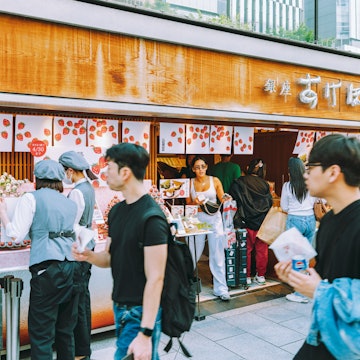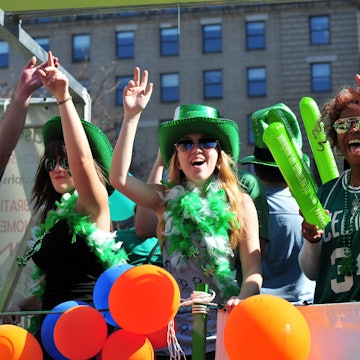

Hiking is a popular pastime in the beautiful surrounds of Chichibu © Yoshio Taniguchi / EyeEm / Getty Images
If you use your imagination and think of Tokyo as an eye, then Saitama Prefecture is like the eyebrow curling around the city from the northeast to the northwest of Tokyo Prefecture. Eastern parts, near the country’s capital, feature countless train lines carrying commuters into Tokyo for the daily grind, while western parts include forest-covered mountains, tea fields, rice paddies and orchards.

Escape to the countryside
For any traveller who has grown tired of the full-on sensory overload of the capital, Saitama Prefecture offers perfectly low-key, off-the-beaten-track cultural experiences, and a chance to discover the real Japan away from ever-increasing visitor numbers in Tokyo.
This is where you come to indulge in hands-on learning about washi paper-making techniques, designing a ceramic teacup while sipping Japanese tea and chatting with the instructor, or studying the art of bonsai (the cultivation of miniature trees) at the Omiya Bonsai Art Museum. Experience a rattan weaving workshop and handcraft your own original pair of rattan coasters, or make your own Japanese doll in Iwatsuki, known as the ‘the town of dolls’. You have the opportunity to not only learn about Japanese art from the masters themselves, but create a unique memento to take home as a souvenir of the experience.

Discover the many delights of Chichibu
An absolute must-see experience can be found in the mountainous west of Saitama Prefecture: the small town of Chichibu. It’s known throughout Japan for the Chichibu Sanjūyon-kasho, a 34-temple Buddhist pilgrimage that covers 100 kilometres and dates back to the early 13th century. The temples are dedicated to Kannon, deity of compassion and mercy. All have free admission and are easy to visit.
Chichibu also offers up some excellent hiking in the surrounding mountains, especially around Mitsumine-jinja, an atmospheric Shinto shrine at the summit of the mountain of the same name. The Chichibu mountains are also known for their mineral-rich water, perfect for making sake. Matsuoka Brewery, established there in 1851, produces award-winning sake with a fruity aroma and a unique, mild taste. An innovative operation, Matsuoka also produces citrus- and lemon-flavoured brews, plus a chocolate-flavoured sake that is recommended as a perfect gift for Valentine’s Day! Make sure you take some Daiginjō sake home to savour at your leisure; it’s come out on top on eight separate occasions at the National Sake Competition. Due to the popularity of the brewery, you’ll need to book ahead for free English-language tours.

While you explore the delights of the region, base yourself at Miyamotoke Ryokan, a traditional Japanese inn. The current owner, Kazuteru Miyamoto, is the twelfth member of the Miyamoto family to own the ryokan and is a former sumo wrestler. Enjoy the hospitality that features tatami-mat rooms, an onsen (hot springs bath) and amazing food with the freshest farm-to-table ingredients available.
If you’re planning a visit during December, the Chichibu Night Festival is the ideal distraction from a cold winter night. The historic Chichibu Yomatsuri is officially one of the Three Great Float Festivals of Japan. Watch two fabulously festooned kasaboko (huge parasol-like objects) and two yatai (house-shaped floats) paraded through the dark city streets. Proceedings are particularly exciting on the night of 3rd December, when the mighty floats (which can weigh up to 20 tonnes) are carried up a steep slope, to a chorus of drumbeats and flute-whistles, and the raucous cheers of the crowds. A battery of fireworks accompanies the efforts, bringing brilliant illumination to the chill, inky skies.

Step back in time in Kawagoe
East of Chichibu, and only an hour by train from Tokyo station, lies the small town of Kawagoe. Its main street is lined with kurazukuri, clay-walled warehouse buildings, reminiscent of a town from the Edo Period (1603-1867). Nicknamed ‘Little Edo’, Kawagoe’s symbol is its beautiful 16m-high wooden bell tower with famous bells that chime four times daily. This gem of a town also boasts Kita-in, a Buddhist temple that offers something marvellously different. As well as having historic buildings and a beautiful garden, it houses 500 rakan. These lifelike statues represent disciples of Buddha who attained enlightenment, left the mundane world and lived in a state of nirvana. They were cut in stone between 1782 and 1825 and each has its own facial features and personality. Legend says that everyone has a lookalike among the 500 and it’s a lot of fun searching for your own.

Hit a home run in Tokorozawa
It’s not just culture that Saitama Prefecture has in spades – it’s also a great destination for sports fans. Only 20 minutes by train from Tokyo’s Ikebukuro Station, just over the prefectural border in Saitama, Tokorozawa is on Japanese television screens almost daily during baseball season. Its stadium, the Seibu Dome, is home to the Saitama Seibu Lions, a popular and successful professional baseball team owned by the Seibu Group – who also own department stores, hotels and railway lines. Going to a Japanese baseball game is more than just a baseball experience, with fans enthusiastically participating in co-ordinated chants and songs of support that are almost as entertaining as the game itself. While in Tokorozawa, aviation enthusiasts should make time to visit the Tokorozawa Aviation Museum on the site of Japan’s first airfield, which started operations in 1911.
While most Japanese tea is grown in the south and west of the country, Sayama-cha (Sayama tea), grown near Tokorozawa, is known as one of the greatest green teas of Japan along with Shizuoka-cha (Shizuoka Prefecture) and Uji-cha (Kyoto Prefecture). Green tea buffs can visit farm tea shops by themselves, as part of a tour, or if in Japan in late April, turn up for the Tokorozawa Tea Festival. Visitors can also head to Sayama Berryland, one of Japan’s largest blueberry and strawberry farms, for berry picking and shiitake mushroom hunting.
So, while Saitama Prefecture might not have a big-ticket attraction such as a DisneySea, Tokyo Skytree or a Shibuya ‘scramble crossing’, it has a lot to offer those in search of a genuine Japanese experience that few foreigners get to enjoy. Make the effort to get out of Tokyo and see what nearby Saitama Prefecture has to offer.
Produced by Lonely Planet for the Saitama Prefectural Government Department of Industry and Labor Tourism Division. All editorial views are those of Lonely Planet alone and reflect our policy of editorial independence and impartiality.
















